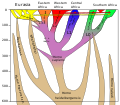File:Homo lineage 2017update.svg
閱讀設定

呢個「SVG」檔案嘅呢個「PNG」預覽嘅大細:675 × 498 像素。 第啲解像度:320 × 236 像素|640 × 472 像素|1,024 × 755 像素|1,280 × 944 像素|2,560 × 1,889 像素。
原本檔案 (SVG檔案,表面大細: 675 × 498 像素,檔案大細:21 KB)
檔案歷史
撳個日期/時間去睇響嗰個時間出現過嘅檔案。
| 日期/時間 | 縮圖 | 尺寸 | 用戶 | 註解 | |
|---|---|---|---|---|---|
| 現時 | 2017年12月20號 (三) 11:02 |  | 675 × 498(21 KB) | Dbachmann | |
| 2017年12月20號 (三) 09:27 |  | 675 × 498(20 KB) | Dbachmann | ||
| 2017年12月20號 (三) 08:54 |  | 675 × 498(19 KB) | Dbachmann | {{Information |Description= |Source= |Date= |Author= |Permission= |other_versions= }} | |
| 2017年12月19號 (二) 10:44 |  | 561 × 465(16 KB) | Dbachmann | User created page with UploadWizard |
檔案用途
以下嘅1版用到呢個檔:
全域檔案使用情況
下面嘅維基都用緊呢個檔案:
- af.wikipedia.org嘅使用情況
- cs.wikipedia.org嘅使用情況
- en.wikipedia.org嘅使用情況
- es.wikipedia.org嘅使用情況
- eu.wikipedia.org嘅使用情況
- fa.wikipedia.org嘅使用情況
- id.wikipedia.org嘅使用情況
- ja.wikipedia.org嘅使用情況
- pl.wikibooks.org嘅使用情況
- pt.wikipedia.org嘅使用情況
- ro.wikipedia.org嘅使用情況
- ru.wikipedia.org嘅使用情況
- te.wikipedia.org嘅使用情況
- uk.wikipedia.org嘅使用情況
- vi.wikipedia.org嘅使用情況





